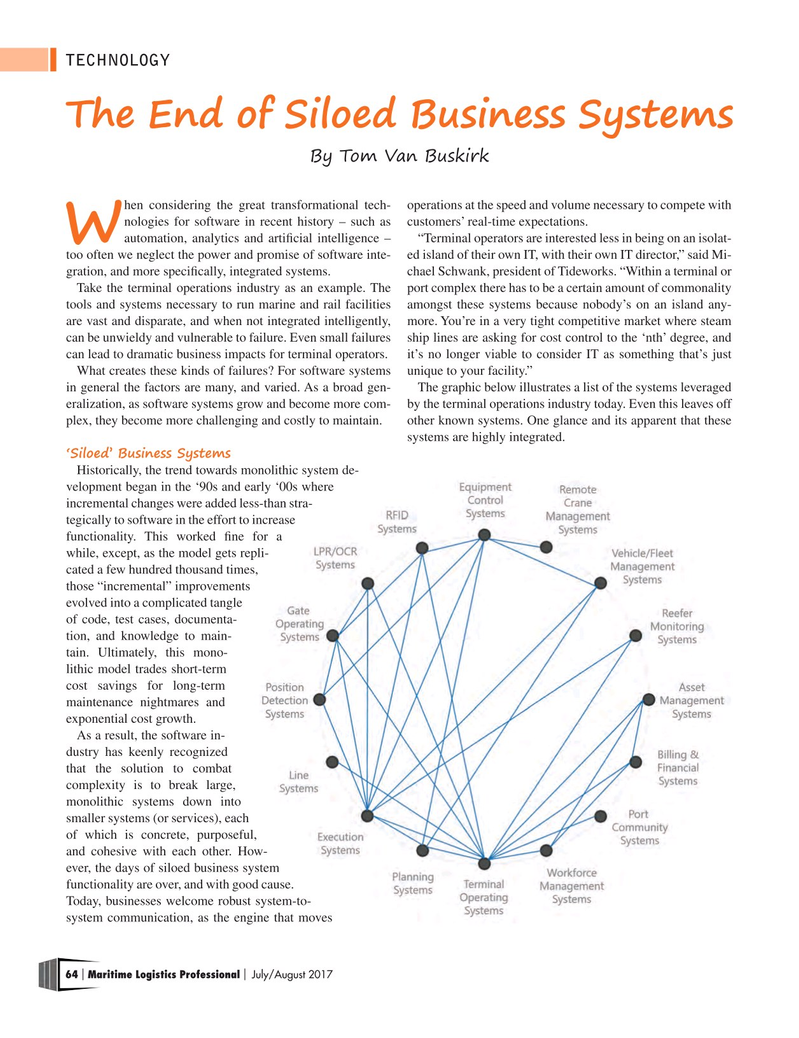
Page 64: of Maritime Logistics Professional Magazine (Jul/Aug 2017)
PORTS & INFRASTRUCTURE
Read this page in Pdf, Flash or Html5 edition of Jul/Aug 2017 Maritime Logistics Professional Magazine
TECHNOLOGY
The End of Siloed Business Systems
By Tom Van Buskirk hen considering the great transformational tech- operations at the speed and volume necessary to compete with nologies for software in recent history – such as customers’ real-time expectations.
W automation, analytics and artifcial intelligence – “Terminal operators are interested less in being on an isolat- too often we neglect the power and promise of software inte- ed island of their own IT, with their own IT director,” said Mi- gration, and more specifcally, integrated systems. chael Schwank, president of Tideworks. “Within a terminal or
Take the terminal operations industry as an example. The port complex there has to be a certain amount of commonality tools and systems necessary to run marine and rail facilities amongst these systems because nobody’s on an island any- are vast and disparate, and when not integrated intelligently, more. You’re in a very tight competitive market where steam can be unwieldy and vulnerable to failure. Even small failures ship lines are asking for cost control to the ‘nth’ degree, and can lead to dramatic business impacts for terminal operators. it’s no longer viable to consider IT as something that’s just
What creates these kinds of failures? For software systems unique to your facility.” in general the factors are many, and varied. As a broad gen- The graphic below illustrates a list of the systems leveraged eralization, as software systems grow and become more com- by the terminal operations industry today. Even this leaves off plex, they become more challenging and costly to maintain. other known systems. One glance and its apparent that these systems are highly integrated.
‘Siloed’ Business Systems
Historically, the trend towards monolithic system de- velopment began in the ‘90s and early ‘00s where incremental changes were added less-than stra- tegically to software in the effort to increase functionality. This worked fne for a while, except, as the model gets repli- cated a few hundred thousand times, those “incremental” improvements evolved into a complicated tangle of code, test cases, documenta- tion, and knowledge to main- tain. Ultimately, this mono- lithic model trades short-term cost savings for long-term maintenance nightmares and exponential cost growth.
As a result, the software in- dustry has keenly recognized that the solution to combat complexity is to break large, monolithic systems down into smaller systems (or services), each of which is concrete, purposeful, and cohesive with each other. How- ever, the days of siloed business system functionality are over, and with good cause.
Today, businesses welcome robust system-to- system communication, as the engine that moves 64 Maritime Logistics Professional July/August 2017 | |

 63
63

 65
65
